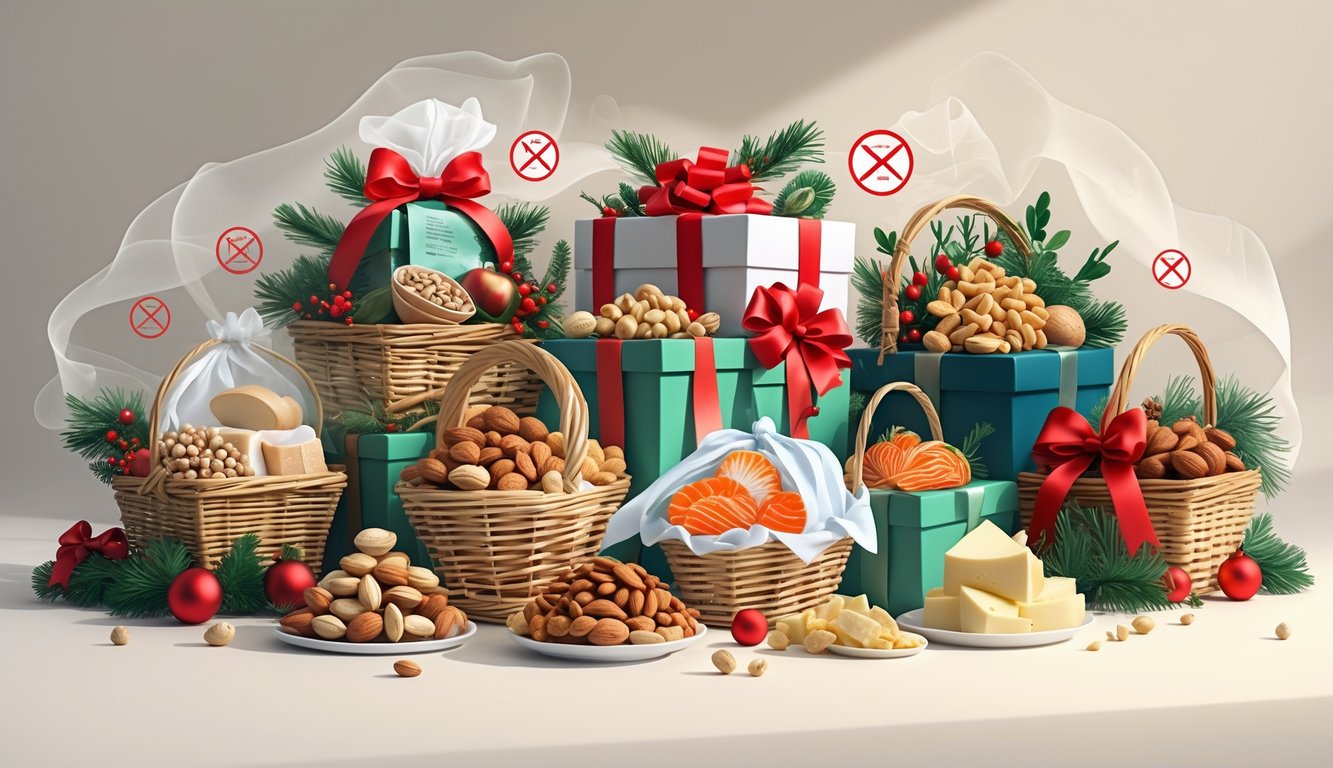
Food Labeling Pitfalls in Holiday Gift Baskets

Honestly, it’s a mess. You’re unwrapping a fancy basket, and suddenly you’re googling “whey protein anaphylaxis” because the fudge bar’s label looks like it was written by a bot. Labels are supposed to help, but they’re often useless—especially on those glossy gift boxes everyone loves to give in December.
Unclear Ingredient Lists
Last December, I squinted at a caramel popcorn bag: “corn, sugar, natural flavors, spices, may contain…other stuff.” What is “other stuff?” Blanket terms like “flavorings” or “spices” are a joke for allergy safety. Doctors hate this. Food Standards Agency says clear labeling is non-negotiable, but brands get creative with language. One missed “almond extract” and you’re in trouble. Flashy packaging wins over transparency every time.
And the ingredient lists? They’re hidden under ribbons, stuffed in corners, or printed so tiny you need a magnifying glass. I had to peel off a sticker just to read what was in the truffles. Who thought that was a good idea?
Vague Allergen Warnings
“May contain traces of nuts.” Oh, cool, super helpful—what does that even mean? Were nuts in the room? Did a spatula touch something? European rules say be specific, but holiday baskets just toss out these warnings like confetti. Shouldn’t this be a law?
Last winter, a fancy gift basket had cheese bites with a warning: “produced in a facility handling dairy/wheat/soya/nuts/sesame.” No details, no real info about cross-contamination. Food Standards Agency recommends clear statements, but good luck finding them. Sometimes your only option is to regift the whole thing—so much for a thoughtful present.
And don’t get me started on contradictory labels: “nut-free” in big letters, then “may contain nuts” in the fine print. Makes you want to scream. Consumer protection? Feels like a joke most days.
Imported Goods With Incomplete Labels
So, here we go again—last week I cracked open these shiny chocolate biscuits from Belgium (they looked way too good, honestly), and guess what? Not a single English word except “Best Before: 10.04.26.” Seriously? I ended up hunched over my phone, zooming in on some fuzzy PDF, trying to figure out if “melk” was milk or something else. Why does every imported snack in these gift towers turn into a code-breaking exercise? Is it supposed to be fun? Because it’s not.
And it’s not just the language thing. Sometimes you get these boxes with zero info: no manufacturer, no allergen warnings, not even a nutritional panel. The Food Standards Agency says you’ve gotta highlight all allergens, whether it’s non-prepacked or pre-packed food, but imports just… don’t? They skate by with whatever old rules they feel like. When someone ends up in the hospital because of a missing allergen label, it’s always after the fact. That’s the “holiday magic,” right? Watching bureaucracy fail in real time, with snacks.
And when you ask the shop or the company, they just shrug. No extra leaflet, no QR code, nothing. Just hope you’re lucky and maybe Google Lens can bail you out. Spoiler: it usually can’t.
Risks of Cross-Contamination in Gift Basket Assembly
I swear, every year someone dumps in “safe” snacks—like peanut-laced cheese, random crackers, stuff nobody even likes—and suddenly the allergen warnings are a total mystery. Cross-contamination isn’t just some myth for germaphobes; if the basics get skipped, every single step adds more risk.
Shared Equipment Concerns
Oh, and that whole “just use a clean knife” thing? Total joke. One rushed swipe with a cheese spreader (used for walnut brie yesterday, “cleaned” in a hurry) and now your “gluten-free” bread is a nut bomb. FDA says cross-contact is one of the top reasons allergens sneak into packaged foods, but everyone acts surprised when Grandma’s “nut-free” bark sends someone to the ER. A 2023 safety report called out shared tools and surfaces as “critical points,” and honestly, I don’t need a study—my friend Sam landed in urgent care after a supposedly “safe” basket last year.
I’ve watched staff at fancy shops barely wipe down counters, just shuffling from cheese to sausage to cookies. Looks clean, but, yeah, grab a black light and you’ll see the horror show. A recent food safety guide says you should wash, rinse, sanitize, and air-dry everything, including the baskets. But, sure, let’s just wipe things with lemony wipes and call it a day. Does that even do anything? Doubt it.
Improper Packaging Methods
People think wrapping everything in foil solves the problem. Nope. I’ve seen the back rooms—peanut brittle right next to “allergen-free” bars, crumbs everywhere, powder in the air. Total contamination. Some food safety group warned it’s the invisible stuff—tiny dust, flakes, whatever—that really spreads allergens. Labels don’t matter if nobody changes gloves or puts a “nut-free” box on a dirty mat.
And the “six-inch storage space” rule? (Here’s the official guideline, if you care)—it doesn’t help if the same person assembles both nutty and “safe” snacks at the same table. Dr. Nguyen (my allergist, and a bit of a legend) says most incidents are from tiny mistakes, not big ones. On paper, everything looks perfect, but in reality, people rush, multitask, and baskets get packed in chaotic, stuffy rooms. Contamination isn’t rare, it’s pretty much guaranteed. Still can’t unsee someone slapping a “tree nut free” sticker on a box right after scooping cashews.